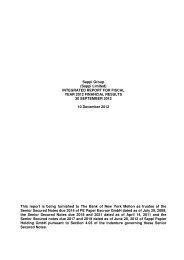2007 Annual Report - Sappi
2007 Annual Report - Sappi
2007 Annual Report - Sappi
You also want an ePaper? Increase the reach of your titles
YUMPU automatically turns print PDFs into web optimized ePapers that Google loves.
31. Financial Instruments continued<br />
The fair value of foreign currency contracts have been computed by the group based upon the market data valid on<br />
30 September <strong>2007</strong>.<br />
All forward currency exchange contracts are valued at fair value with the resultant profit or loss included in the net finance<br />
costs for the period.<br />
Forward exchange contracts are used to hedge the group from potential unfavourable exchange rate movements that may<br />
occurs on recognised financial assets and liabilities or planned future commitments.<br />
The foreign currency forward exchange contracts have different maturities, with the most extended maturity date is<br />
September 2008.<br />
As at the year end there was an open exposure of US$44.8 million which will have to be covered within three working days<br />
as per the treasury policy.<br />
Sensitivity analysis<br />
In USD<br />
Gain (loss)<br />
Base currency US$ million Exposure +10% -10%<br />
EUR (9.4) (0.9) 1.0<br />
GBP (21.3) (1.9) 2.4<br />
USD 3.0 0.3 (0.3)<br />
ZAR (23.9) (2.1) 2.7<br />
Other currencies 6.8 0.6 (0.8)<br />
Total (44.8) (4.0) 5.0<br />
5. Hedge accounting<br />
The group has the following fair value hedges which qualify for hedge accounting:<br />
Bonds at fixed interest rates for a total notional amount of US$856 million are hedged by seven external interest rate swaps<br />
(IRS), with a negative fair value of US$10.2 million which convert the USD fixed interest rates into floating 6-month LIBOR in<br />
arrears. The hedged risk is designated to be the interest rate risk arising from fluctuations in the US Libor swap curve. The<br />
effect of this transaction is to convert fixed rate debt into floating rate debt.<br />
In fiscal 2005 the hedge was de-designated and re-designated. During this period hedge accounting was interrupted for a<br />
certain number of deals. The changes in fair value of the bonds until the moment of de-designation are amortised over the<br />
remaining life of the hedge.<br />
In fiscal <strong>2007</strong> <strong>Sappi</strong> decided to replace their valuation and hedge effectiveness tool with the REVALHedgeRx. It was decided<br />
to switch from the Volatility Reduction Method (VRM) and the Volatility Variance Method (VVM), and to use the linear regression<br />
analysis method as an alternative statistical test, which is appropriate to test hedge effectiveness of a fair value hedge.<br />
A change in the hedge effectiveness measurement methodology requires the de-designation of the existing hedge relationship.<br />
Simultaneously a re-designation of the same hedge relationship was carried out catering however for a revised hedge<br />
effectiveness measurement methodology. There was no material impact on the income statement as a result of this change.<br />
As the swaps were contracted after the issuance of the underlying bonds, at the time of designating the hedge relationship<br />
it was required to mark-to-market the bonds in order to create an initial market value benchmark which was different to the<br />
face value as market condtions had changed since inception of the bonds. All future mark-to-markets of the bonds are<br />
measured against this benchmark.<br />
sappi limited | 07 | annual report 149
















